Preparation of Network-Structured Carbon Nanofiber Mats Based on PAN Blends Using Electrospinning and Hot-Pressing Methods for Supercapacitor Applications
Abstract
:1. Introduction
2. Materials and Methods
2.1. Materials
2.2. Preparation of Network-Structured Carbon Nanofibers
2.3. Assembly of Asymmetric Hybrid Supercapacitors
2.4. Electrochemical Characterization
2.5. Characterization
3. Results and Discussion
4. Conclusions
Supplementary Materials
Author Contributions
Funding
Institutional Review Board Statement
Informed Consent Statement
Data Availability Statement
Acknowledgments
Conflicts of Interest
References
- Jorn-am, T.; Praneerad, J.; Attajak, R.; Sirisit, N.; Manyam, J.; Paoprasert, P. Quasi-solid, bio-renewable supercapacitor with high specific capacitance and energy density based on rice electrolytes and rice straw-derived carbon dots as novel electrolyte additives. Colloids Surf. A: Physicochem. Eng. Asp. 2021, 628, 127239. [Google Scholar]
- Kong, M.; Wang, Z.; Wang, W.; Min, M.; Liu, D.; Hao, S.; Kong, R.; Du, G.; Asiri, A.M.; Yao, Y.; et al. NiCoP nanoaray: A superior pseudocapacitor electrode with high areal capacitance. Chem. A Eur. J. 2017, 23, 4435–4441. [Google Scholar] [CrossRef] [PubMed]
- Ko, T.H.; Radhakrishnan, S.; Seo, M.K.; Khil, M.S.; Kim, H.Y.; Kim, B.S. A green and scalable dry synthesis of NiCo2O4/graphene nanohybrids for high-performance supercapacitor and enzymeless glucose biosensor applications. J. Alloys Compd. 2017, 696, 193–200. [Google Scholar] [CrossRef]
- Li, Y.; Zhu, G.; Huang, H.; Xu, M.; Lu, T.; Pan, L. A N, S dual doping strategy via electrospinning to prepare hierarchically porous carbon polyhedral embedded carbon nanofibers for flexible supercapacitors. J. Mater. Chem. A 2019, 7, 9040–9050. [Google Scholar] [CrossRef]
- Saravanakumar, B.; Ko, T.H.; Kim, B.S. Rational design of binder-free ZnCo2O4 and Fe2O3 decorated porous 3D Ni as high-performance electrodes for asymmetric supercapacitor. Ceram. Int. 2018, 44, 10635–10645. [Google Scholar] [CrossRef]
- Chen, C.; Zhao, M.; Cai, Y.; Zhao, G.; Xie, Y.; Zhang, L.; Zhu, G.; Pan, L. Scalable synthesis of strutted nitrogen doped hierarchical porous carbon nanosheets for supercapacitors with both high gravimetric and volumetric performances. Carbon 2021, 179, 458–468. [Google Scholar] [CrossRef]
- Wannasen, L.; Mongkolthanaruk, W.; Swatsitang, E.; Pavasant, P.; Pinitsoontorn, S. Co2P2O7 Microplate/Bacterial Cellulose–Derived Carbon Nanofiber Composites with Enhanced Electrochemical Performance. Nanomaterials 2021, 11, 2015. [Google Scholar] [CrossRef] [PubMed]
- Liang, R.; Du, Y.; Xiao, P.; Cheng, J.; Yuan, S.; Chen, Y.; Chen, J. Transition Metal Oxide Electrode Materials for Supercapacitors: A Review of Recent Developments. Nanomaterials 2021, 11, 1248. [Google Scholar] [CrossRef] [PubMed]
- Lei, D.; Li, X.D.; Seo, M.K.; Khil, M.S.; Kim, H.Y.; Kim, B.S. NiCo2O4 nanostructure-decorated PAN/lignin based carbon nanofiber electrodes with excellent cyclability for flexible hybrid supercapacitors. Polymer 2017, 132, 31–40. [Google Scholar] [CrossRef]
- Tian, L.; Mingxian, L.; Dazhang, Z.; Gan, L.; Chen, T. Nanocarbon-based materials for flexible all-solid-state supercapacitors. Adv. Mater. 2018, 30, 1705489. [Google Scholar]
- Cao, Y.; Liang, J.; Li, X.; Yue, L.; Liu, Q.; Lu, S.; Abdullah, M.A.; Jianming, H.; Luo, Y.; Sun, X. Recent advances in perovskite oxides as electrode materials for supercapacitors. Chem. Commun. 2021, 57, 2343–2355. [Google Scholar] [CrossRef] [PubMed]
- Chen, L.; Xu, X.; Wan, L.; Zhu, G.; Li, Y.; Lu, T.; Albaqami, M.D.; Pan, L.; Yamauchi, Y. Carbon-incorporated Fe3O4 nanoflakes: High-performance faradic materials for hybrid capacitive deionization and supercapacitors. Mater. Chem. Front. 2021, 5, 3480–3488. [Google Scholar] [CrossRef]
- Liang, J.; Zhao, H.; Yue, L.; Fan, G.; Li, T.; Lu, S.; Sun, X. Recent advances in electrospun nanofibers for supercapacitors. J. Mater. Chem. A 2020, 8, 16747. [Google Scholar] [CrossRef]
- Xu, X.; Liu, Y.; Wang, M.; Zhu, C.; Lu, T.; Zhao, R.; Pan, L. Hierarchical hybrids with microporous carbon spheres decorated three-dimensional graphene frameworks for capacitive applications in supercapacitor and deionization. Electrochim. Acta 2016, 193, 88–95. [Google Scholar] [CrossRef]
- Pan, Z.; Liu, M.; Yang, J.; Qiu, Y.; Li, W.; Xu, Y.; Zhang, Y. High electroactive material loading on a carbon nanotube@ 3D graphene aerogel for high-performance flexible all-solid-state asymmetric supercapacitors. Adv. Funct. Mater. 2017, 27, 1701122. [Google Scholar] [CrossRef]
- Zhang, Z.; Wang, L.; Li, Y.; Wang, Y.; Zhang, J.; Guan, G.; Peng, H. Nitrogen-doped core-sheath carbon nanotube array for highly stretchable supercapacitor. Adv. Energy Mater. 2017, 7, 1601814. [Google Scholar] [CrossRef]
- Xiao, Y.; Xu, Y.; Zhang, K.; Tang, X.; Huang, J.; Yuan, K.; Chen, Y. Coaxial electrospun free-standing and mechanically stable hierarchical porous carbon nanofiber membranes for flexible supercapacitors. Carbon 2020, 160, 80–87. [Google Scholar] [CrossRef]
- Chen, W.; Wang, H.; Lan, W.; Li, D.; Zhang, A.; Liu, C. Construction of sugarcane bagasse-derived porous and flexible carbon nanofibers by electrospinning for supercapacitors. Ind. Crop. Prod. 2021, 170, 113700. [Google Scholar] [CrossRef]
- Mytafides, C.K.; Tzounis, L.; Karalis, G.; Formanek, P.; Paipetis, A.S. Fully printed and flexible carbon nanotube-based thermoelectric generator capable for high-temperature applications. J. Power Sources 2021, 507, 230323. [Google Scholar] [CrossRef]
- Zhang, Y.; Hui, S.; Lin, X.; Ying, Z.; Li, Y.; Xie, J. Novel effective strategy for high-performance biomass-based super-flexible hierarchically porous carbon fibrous film electrode for supercapacitors. J. Alloys Compd. 2021, 883, 160713. [Google Scholar] [CrossRef]
- Tao, Y.; Liu, W.; Li, Z.; Zheng, Y.; Zhu, X.; Wang, H.; Chen, H. Boosting supercapacitive performance of flexible carbon via surface engineering. J. Colloid Interface Sci. 2021, 602, 636–645. [Google Scholar] [CrossRef]
- Lee, S.W.; Yabuuchi, N.; Gallant, B.M.; Chen, S.; Kim, B.S.; Hammond, P.T.; Shao-Horn, Y. High-power lithium batteries from functionalized carbon-nanotube electrodes. Nat. Nanotechnol. 2010, 5, 531–537. [Google Scholar] [CrossRef]
- Xiong, G.; He, P.; Lyu, Z.; Chen, T.; Huang, B.; Chen, L.; Fisher, T.S. Bioinspired leaves-on-branchlet hybrid carbon nanostructure for supercapacitors. Nat. Commun. 2018, 9, 790. [Google Scholar] [CrossRef] [PubMed] [Green Version]
- Liu, Y.; Hao, M.; Chen, Z.; Liu, L.; Liu, Y.; Yang, W.; Ramakrishna, S. A review on recent advances in application of electrospun nanofiber materials as biosensors. Curr. Opin. Biomed. Eng. 2020, 13, 174–189. [Google Scholar] [CrossRef]
- Alimohammadi, M.; Aghli, Y.; Fakhraei, O.; Moradi, A.; Passandideh-Fard, M.; Ebrahimzadeh, M.H.; Mousavi Shaegh, S.A. Electrospun nanofibrous membranes for preventing tendon adhesion. ACS Biomater. Sci. Eng. 2020, 6, 4356–4376. [Google Scholar] [CrossRef] [PubMed]
- Zhang, Z.; Wu, X.; Kou, Z.; Song, N.; Nie, G.; Wang, C.; Verpoort, F.; Mu, S. Rational Design of Electrospun Nanofiber-Typed Electrocatalysts for Water Splitting: A Review. Chem. Eng. J. 2022, 428, 131133. [Google Scholar] [CrossRef]
- Forghani, S.; Almasi, H.; Moradi, M. Electrospun nanofibers as food freshness and time-temperature indicators: A new approach in food intelligent packaging. Innov. Food Sci. Emerg. Technol. 2021, 73, 102804. [Google Scholar] [CrossRef]
- Guo, H.; Chen, Y.; Li, Y.; Zhou, W.; Xu, W.; Pang, L.; Jiang, S. Electrospun fibrous materials and their applications for electromagnetic interference shielding: A review. Compos. Part. A Appl. Sci. Manuf. 2021, 143, 106309. [Google Scholar] [CrossRef]
- Cui, C.; Sun, S.; Wu, S.; Chen, S.; Ma, J.; Zhou, F. Electrospun chitosan nanofibers for wound healing application. Eng. Regen. 2021, 2, 82–90. [Google Scholar]
- Park, J.; Ko, T.H.; Balasubramaniam, S.; Seo, M.K.; Khil, M.S.; Kim, H.Y.; Kim, B.S. Enhancing the performance and stability of NiCo2O4 nanoneedle coated on Ni foam electrodes with Ni seed layer for supercapacitor applications. Ceram. Int. 2019, 45, 13099–13111. [Google Scholar] [CrossRef]
- Ranjith, K.S.; Kwak, C.H.; Hwang, J.U.; Ghoreishian, S.M.; Raju, G.S.R.; Huh, Y.S.; Im, J.S.; Han, Y.K. High-performance all-solid-state hybrid supercapacitors based on surface-embedded bimetallic oxide nanograins loaded onto carbon nanofiber and activated carbon. Electrochim. Acta 2020, 332, 135494. [Google Scholar] [CrossRef]
- Hajir Bahrami, S.; Bajaj, P.; Sen, K. Thermal behavior of acrylonitrile carboxylic acid copolymers. J. Appl. Polym. Sci. 2003, 88, 685–698. [Google Scholar] [CrossRef]
- Fitzer, E.; Frohs, W.; Heine, M. Optimization of stabilization and carbonization treatment of PAN fibers and structural characterization of the resulting carbon fibers. Carbon 1986, 24, 387–395. [Google Scholar] [CrossRef]
- Yu, X.; Ma, M.; Jan, J. Preparation of multi-layer nylon-6 nanofiber membranes by electrospinning and hot pressing method for dye filtration. RSC Adv. 2018, 8, 12173. [Google Scholar] [CrossRef] [Green Version]
- Shen, T.; Li, C.; Haley, B.; Desai, S.; Strachan, A. Crystalline and pseudo-crystalline phases of polyacrylonitrile from molecular dynamics: Implications for carbon fiber precursors. Polymer 2018, 155, 13–26. [Google Scholar] [CrossRef]
- Ratajczak, P.; Suss, M.E.; Kaasik, F.; Beguin, F. Carbon electrodes for capacitive technologies. Energy Storage Mater. 2019, 16, 126–145. [Google Scholar] [CrossRef]
- Cottineau, T.; Toupin, M.; Delahaye, T.; Brousse, T.; Belanger, D. Nanostructured transition metal oxides for aqueous hybrid electrochemical supercapacitors. Appl. Phys. A 2006, 82, 599–606. [Google Scholar] [CrossRef]
- Raj, C.S.; Manikandan, R.; Rajesh, M.; Sivakumar, P.; Jung, H.; Das, S.J.; Kim, B.C. Cornhusk mesoporous activated carbon electrodes and seawater electrolytes: The sustainable sources for assembling retainable supercapacitor module. J. Power Sources 2021, 490, 229518. [Google Scholar] [CrossRef]
- Madani, S.; Falamaki, C.; Alimadadi, H.; Aboutalebi, S.H. Binder-free reduced graphene oxide 3D structures based on ultra large graphene oxide sheets: High performance green micro-supercapacitor using NaCl electrolyte. J. Energy Storage 2019, 21, 310–320. [Google Scholar] [CrossRef]
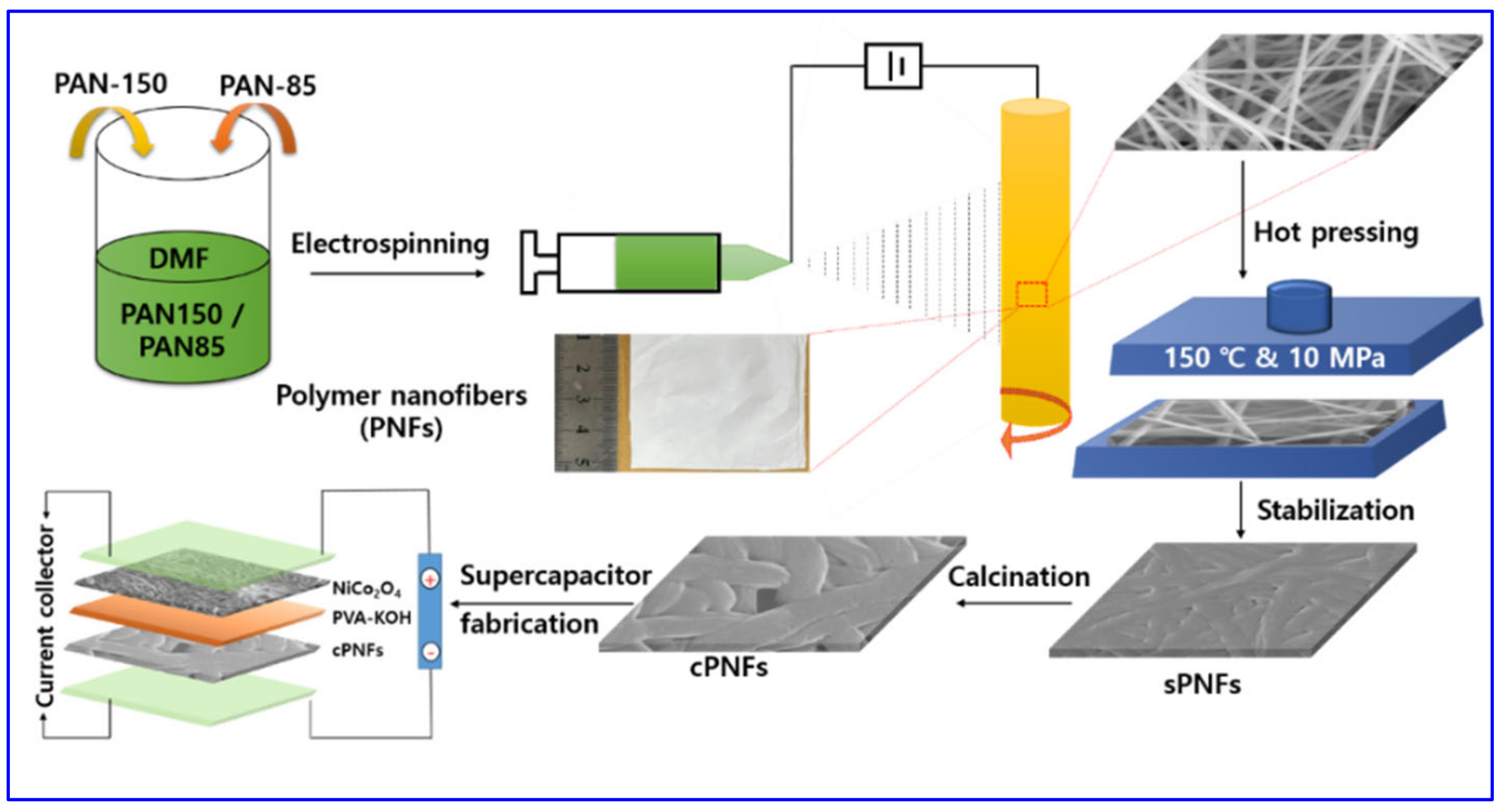
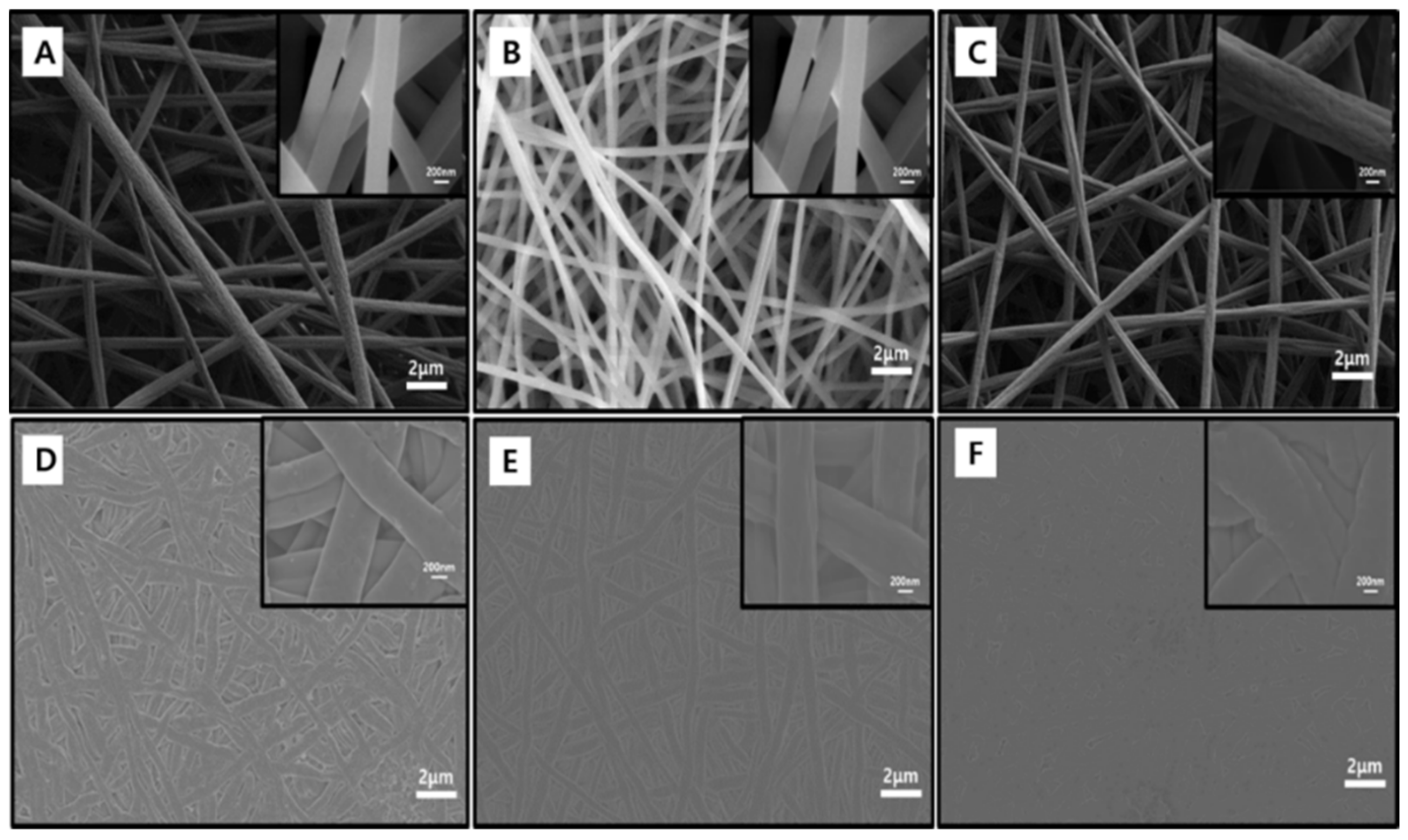
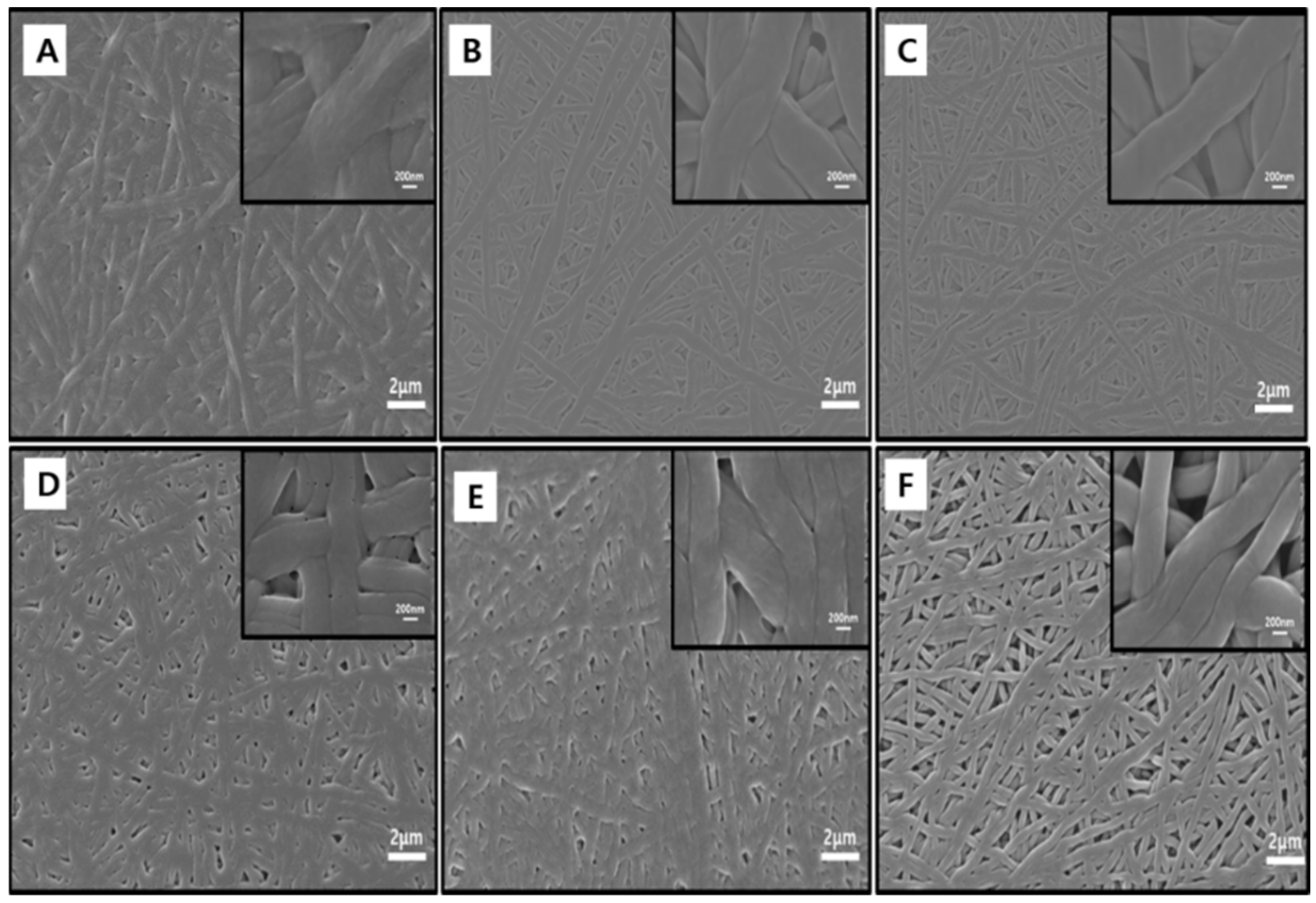
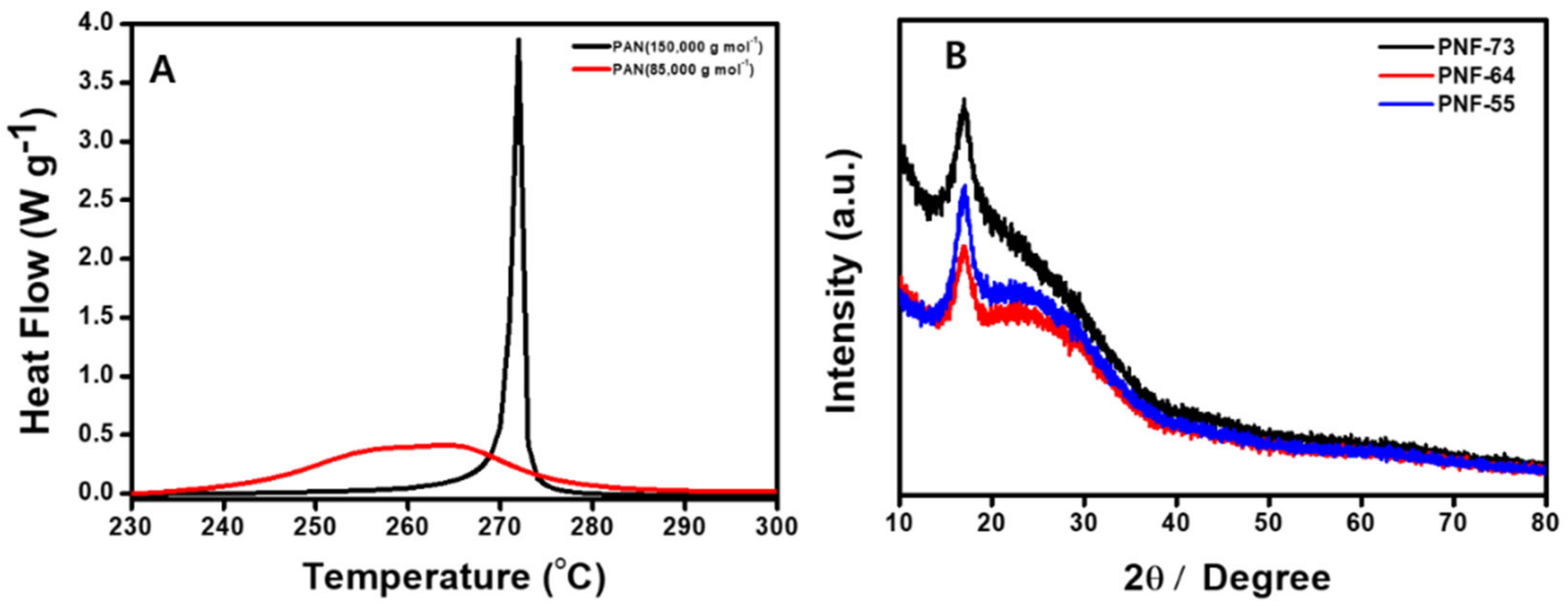
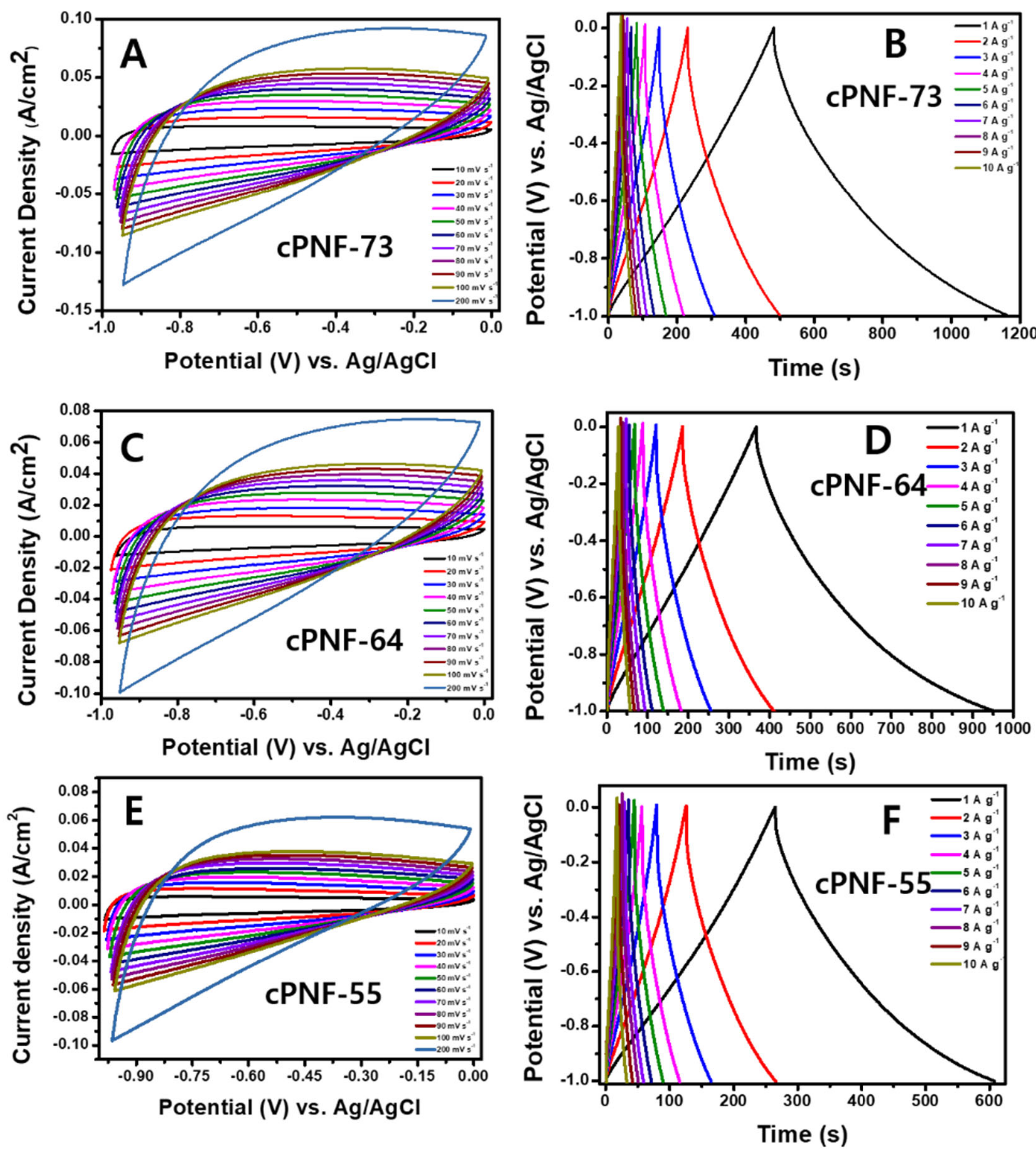
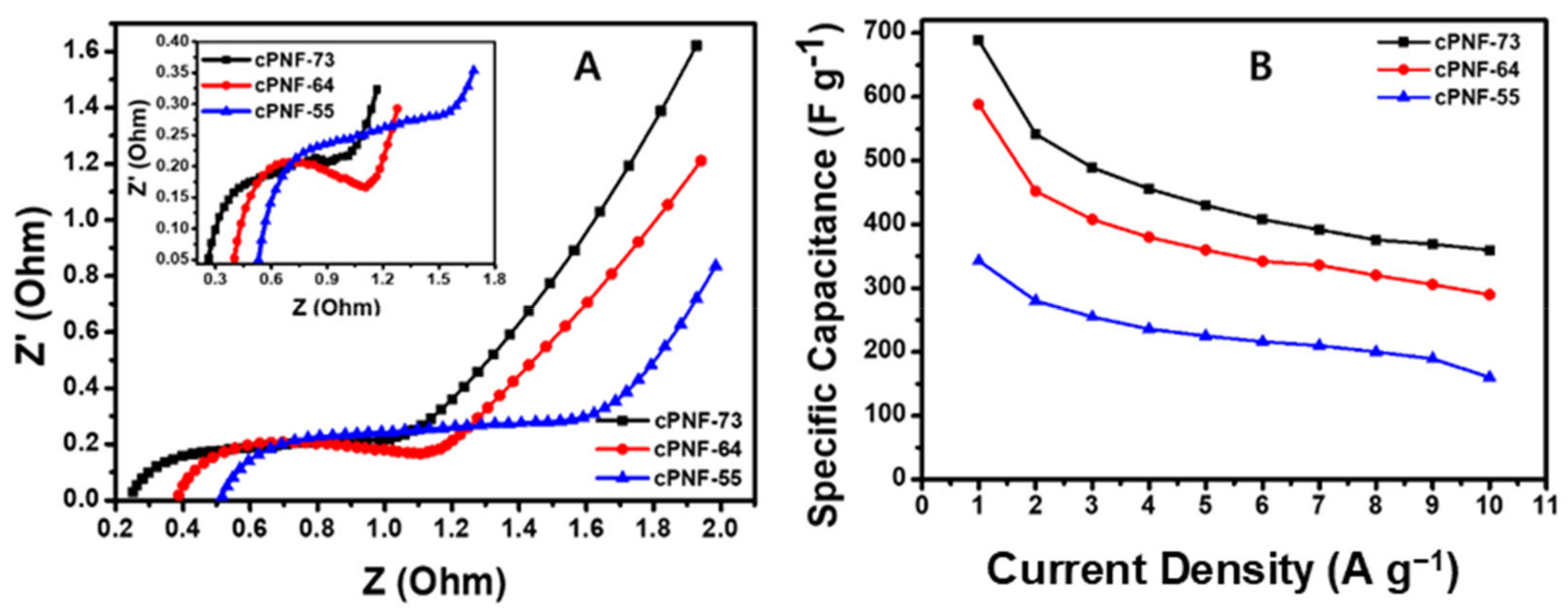
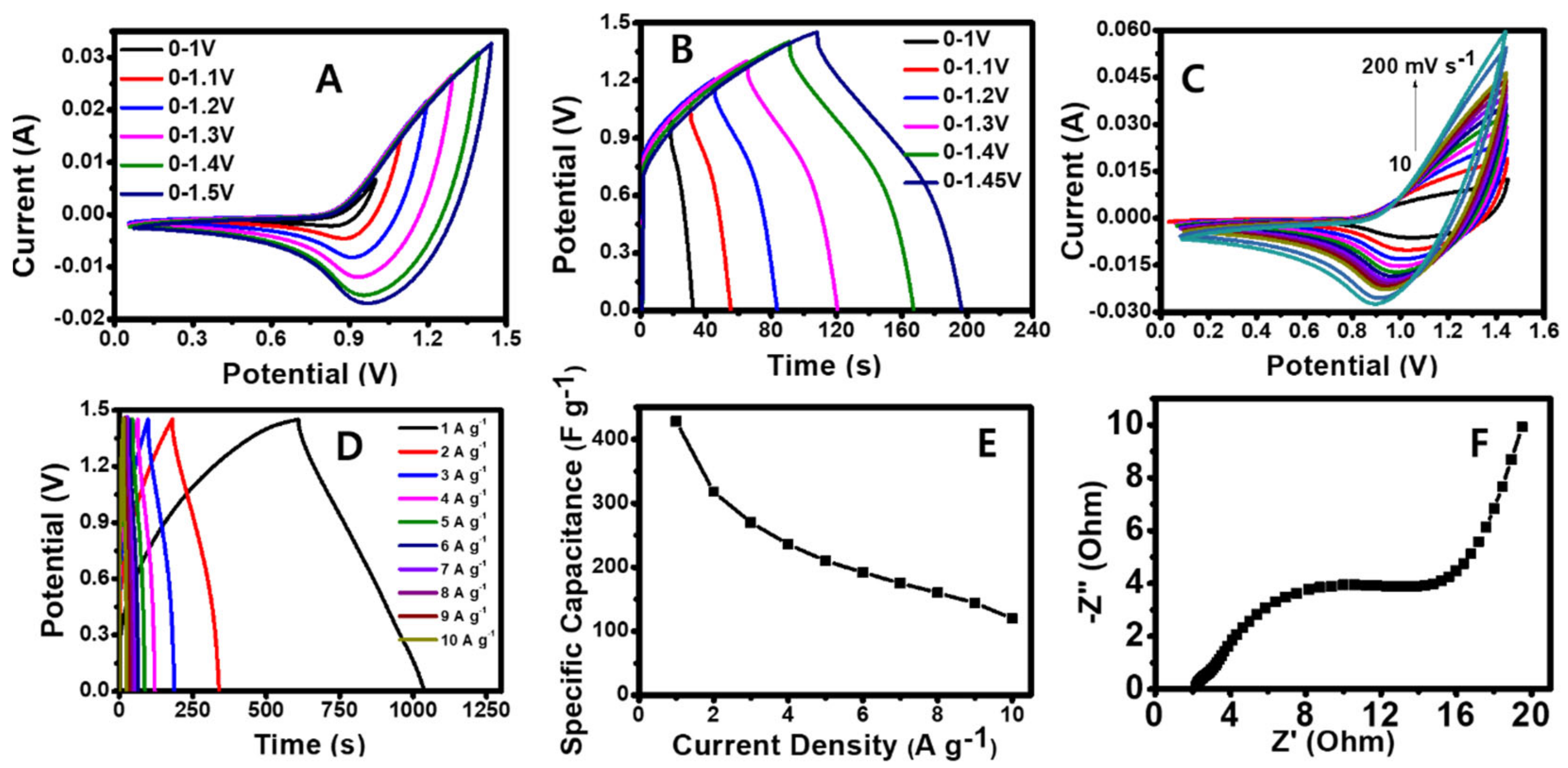
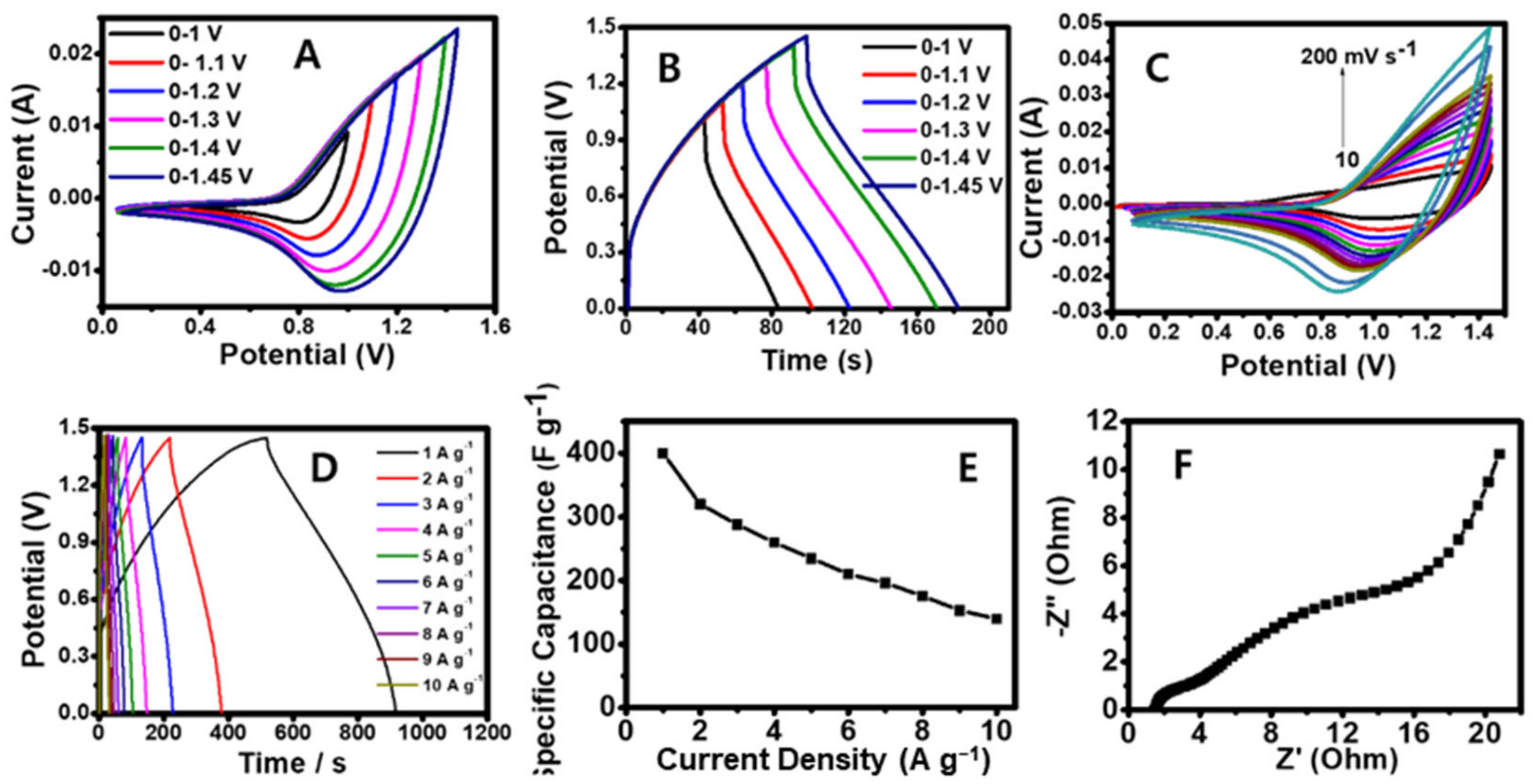
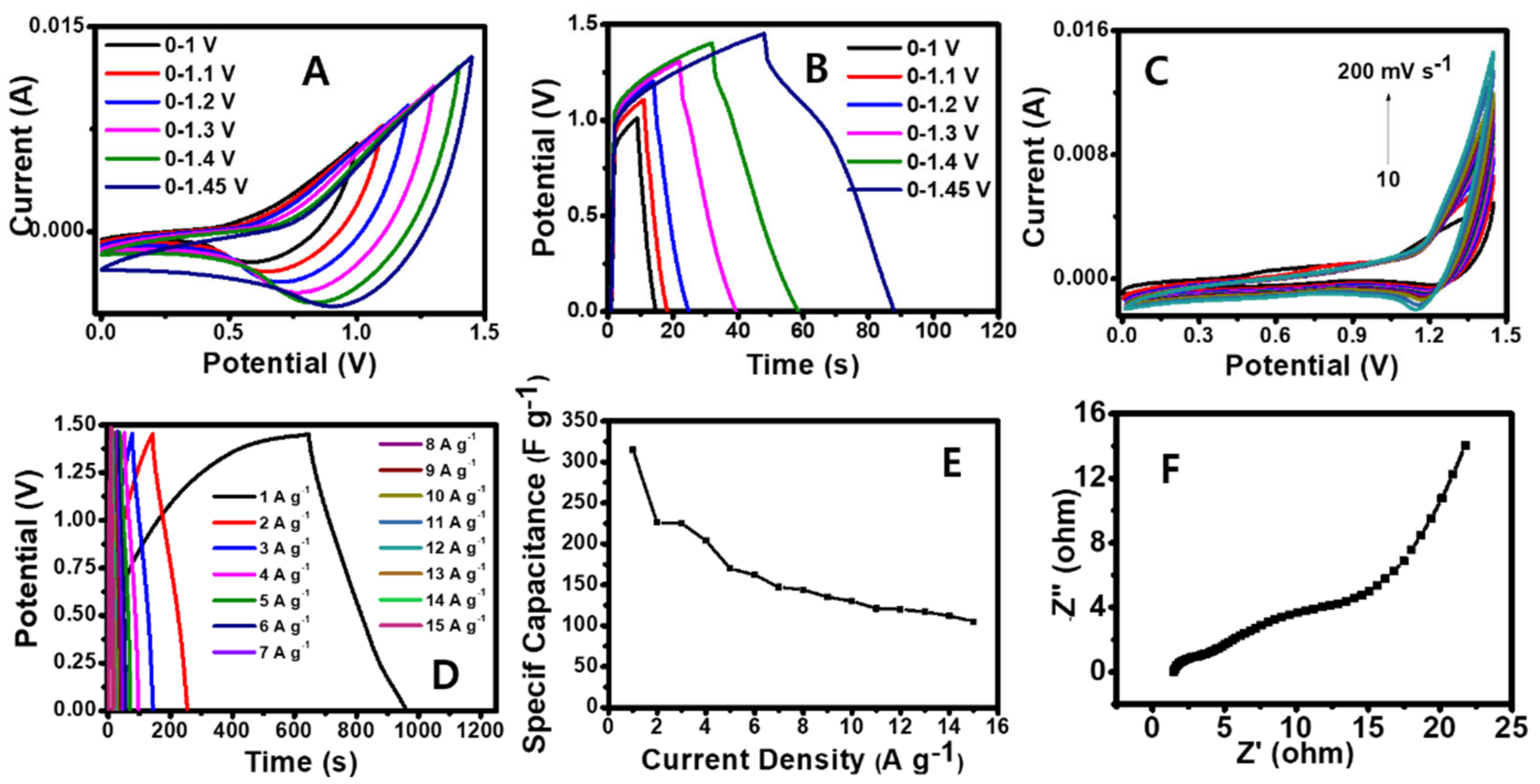
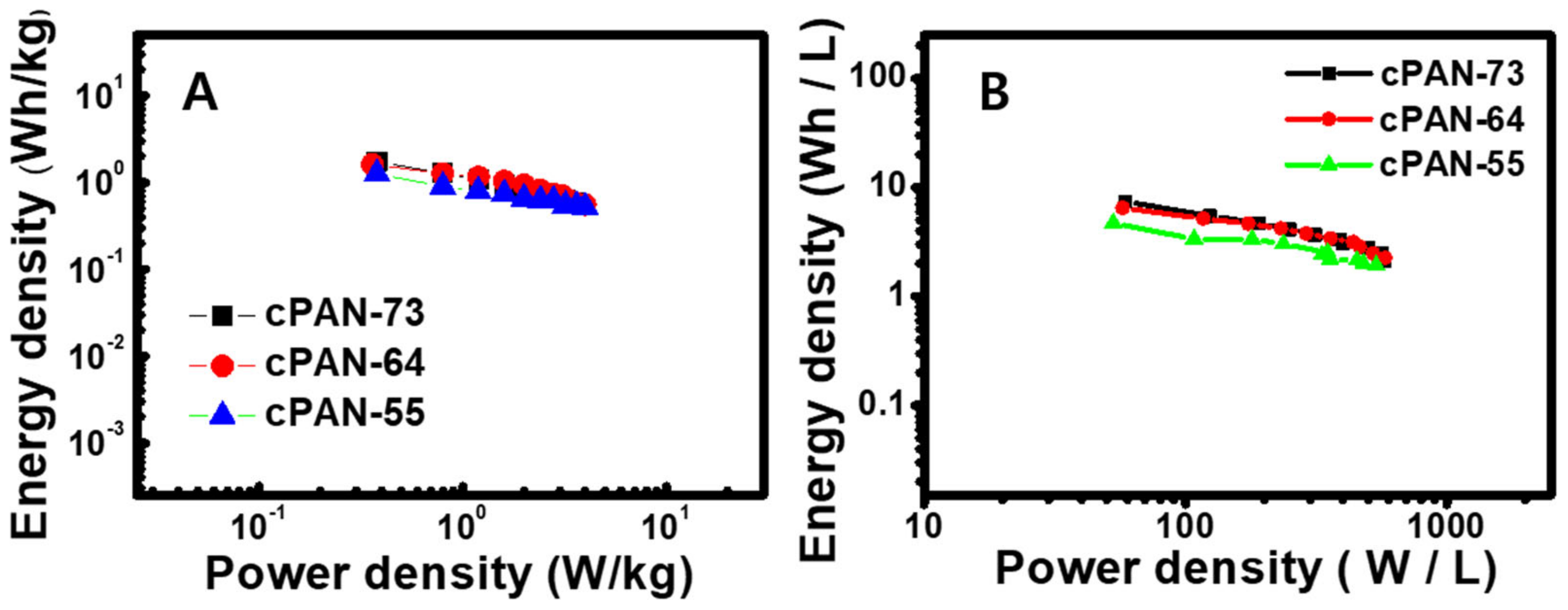
Publisher’s Note: MDPI stays neutral with regard to jurisdictional claims in published maps and institutional affiliations. |
© 2021 by the authors. Licensee MDPI, Basel, Switzerland. This article is an open access article distributed under the terms and conditions of the Creative Commons Attribution (CC BY) license (https://creativecommons.org/licenses/by/4.0/).
Share and Cite
Ma, M.-J.; Seong, J.-G.; Radhakrishnan, S.; Ko, T.-H.; Kim, B.-S. Preparation of Network-Structured Carbon Nanofiber Mats Based on PAN Blends Using Electrospinning and Hot-Pressing Methods for Supercapacitor Applications. Nanomaterials 2021, 11, 2447. https://doi.org/10.3390/nano11092447
Ma M-J, Seong J-G, Radhakrishnan S, Ko T-H, Kim B-S. Preparation of Network-Structured Carbon Nanofiber Mats Based on PAN Blends Using Electrospinning and Hot-Pressing Methods for Supercapacitor Applications. Nanomaterials. 2021; 11(9):2447. https://doi.org/10.3390/nano11092447
Chicago/Turabian StyleMa, Min-Jung, Jae-Gyoung Seong, Sivaprakasam Radhakrishnan, Tae-Hoon Ko, and Byoung-Suhk Kim. 2021. "Preparation of Network-Structured Carbon Nanofiber Mats Based on PAN Blends Using Electrospinning and Hot-Pressing Methods for Supercapacitor Applications" Nanomaterials 11, no. 9: 2447. https://doi.org/10.3390/nano11092447
APA StyleMa, M.-J., Seong, J.-G., Radhakrishnan, S., Ko, T.-H., & Kim, B.-S. (2021). Preparation of Network-Structured Carbon Nanofiber Mats Based on PAN Blends Using Electrospinning and Hot-Pressing Methods for Supercapacitor Applications. Nanomaterials, 11(9), 2447. https://doi.org/10.3390/nano11092447






